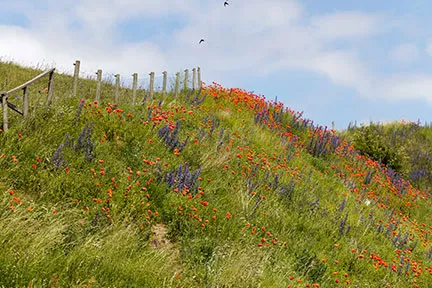Conservation of biodiversity and maintenance of ecosystem services
Synergies and Trade-offs between Conservation of Biodiversity and Maintenance of Ecosystem Services in a Changing Climate
The focus of this cluster is on developing strategies that integrate the conservation of biodiversity in the Swedish agricultural and forest landscapes. To this end, we investigate how species range shifts, population changes and evolutionary responses are affected by the combined effects of climate and habitat change, as well as the trade-offs and synergies between biodiversity conservation and economically viable forestry and agriculture generated by consequences for multiple ecosystem services.
These are the major research areas within Conservation of biodiversity under climate and land-use change:
Range-shifts in a changing climate
A major challenge for ecology is to predict and manage global change impacts on species and ecosystems. One key focus of that research is species’ movement (or stasis), through a shift, expansion, or contraction of their ranges. We aim to identify the potential for species range-shifts in Sweden, and to assess their consequences on biodiversity. We study different taxa, with an emphasis on birds and trees, for which we have long-term data and great in-house expertise.
Read more about Range-shifts in a changing climate
Climate-driven phenological change
Climate change is shifting the phenology of many species throughout the world. At our latitudes, seasonal changes set the framework for how life is organised, not least for all the species that migrate or go into hibernation when resources dwindle in the autumn. Important parts of our research in the light of global and regional climate change is therefore to develop a game-theoretical approaches as well as to improve methods to use satellite imagery to trace changes in vegetation phenology.
Read more about Climate-driven phenological change
Evolutionary change
Understanding the role of marginal populations are important for the long term persistence of adaptive genetic variation. We aim to describe the genetic signature at expanding range margins as well as to understand to what extent populations and species can adapt to new environmental conditions triggered by recent climate change.
Read more about Evolutionary change
Integration of biodiversity in production landscapes
Recent declines of farmland biodiversity, mainly caused by agricultural intensification, threaten cultural values of farmland and as well as ecosystem services underpinned by biodiversity. A major challenge is to meet growing demands for food and fibre, while halting and/or reversing biodiversity declines. The research focuses on how to conserve farmland biodiversity as well as how biodiversity conservation contributes to ecosystem services.
Ecosystem functioning in a changing climate
Aquatic ecosystems will in the future face simultaneous threats from several environmental drivers such as changes in climate and water colour (“brownification”). These threats will not be independent, but will act in concert leading to unpredictable, non-intuitive and hitherto unknown synergistic effects on species interactions, ultimately affecting ecosystem functioning of aquatic systems and their usefulness as resources for humans. We believe that the understanding of complex and synergistic effects among environmental threats is the single most important challenge for the future in order to retain the ecological integrity of aquatic ecosystems and their potential as natural resources.
Read more about the research group
Biodiversity and ecosystem responses to climate change in alpine/arctic areas
In the recent past, substantial evidence has also accumulated that arctic and alpine landscapes are undergoing distinct changes in plant community structure, presumably brought about by increasing temperatures and a prolonged snow-free season. In combining empirical ecosystem studies and ecosystem modelling, we employ a unique approach to improve the understanding of the underlying processes in plant-herbivore interactions and subsequently develop our knowledge on how future climate warming can affect the Swedish mountains.
Read more about the research group
Policies for conservation in a changing climate
Policy interventions for improving the state of the environment are often primarily targeted at species of conservation concern, or at other ecosystem services. As an example, some agri-environment schemes are targeted explicitly at conserving biological diversity, while other policy interventions are targeting more broad environmental goals. The research focuses on whether synergies or trade-offs can emerge between the two types of environmental policies. Of particular interest is to establish such synergies or trade-offs given current rates of global change, including both land-use and climate change.
Read more about the research here


